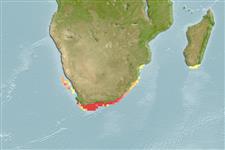>
Centrarchiformes (Basses) >
Latridae (Trumpeters)
Etymology: Chirodactylus: Greek, cheir = hand + Greek, daktylos = finger (Ref. 45335); for the long, unbranched lower pectoral fin rays (Ref. 120445).
More on author: Günther.
Environment: milieu / climate zone / depth range / distribution range
Écologie
marin démersal; profondeur 0 - 150 m (Ref. 9492). Subtropical; 23°S - 36°S
Southeast Atlantic: Walvis Bay, Namibia to possibly Natal, South Africa. Natal records are likely to be Chirodactylus jessicalorum.
Taille / Poids / Âge
Maturity: Lm ? range ? - ? cm
Max length : 180 cm TL mâle / non sexé; (Ref. 9492); common length : 80.0 cm TL mâle / non sexé; (Ref. 9492)
Description synthétique
Clés d'identification | Morphologie | Morphométrie
Épines dorsales (Total) : 17 - 18; Rayons mous dorsaux (Total) : 22 - 24; Épines anales: 3; Rayons mous anaux: 8.
The largest species of the family (Ref. 5319). Primarily an offshore species that prefers rocky or muddy banks. Feeds during the day on small, bottom-dwelling invertebrates. Occasionally also on squid and small fish. Also caught by artisanal and game fisheries (Ref. 9492).
Life cycle and mating behavior
Maturities | Reproduction | Spawnings | Egg(s) | Fecundities | Larves
Smith, M.M., 1986. Cheilodactylidae. p. 667-668. In M.M. Smith and P.C. Heemstra (eds.) Smiths' sea fishes. Springer-Verlag, Berlin. (Ref. 5319)
Statut dans la liste rouge de l'IUCN (Ref. 130435)
Menace pour l'homme
Harmless
Utilisations par l'homme
Pêcheries: intérêt commercial mineur; pêche sportive: oui
Outils
Articles particuliers
Télécharger en XML
Sources Internet
Estimates based on models
Preferred temperature (Ref.
123201): 15.4 - 23.9, mean 18.1 °C (based on 40 cells).
Phylogenetic diversity index (Ref.
82804): PD
50 = 0.6250 [Uniqueness, from 0.5 = low to 2.0 = high].
Bayesian length-weight: a=0.01820 (0.00738 - 0.04487), b=2.99 (2.77 - 3.21), in cm total length, based on LWR estimates for this (Sub)family-body shape (Ref.
93245).
Niveau trophique (Ref.
69278): 3.3 ±0.3 se; based on diet studies.
Résilience (Ref.
120179): Très faible, temps minimum de doublement de population supérieur à 14 ans (Preliminary K or Fecundity.).
Fishing Vulnerability (Ref.
59153): Very high vulnerability (90 of 100).
